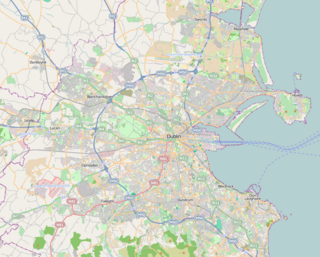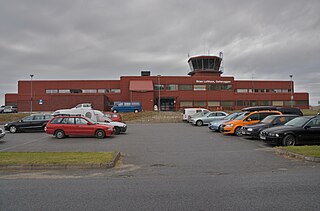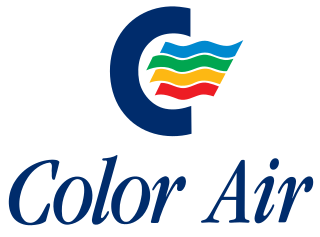Aer Lingus is the flag carrier of Ireland. Founded by the Irish government, it was privatised between 2006 and 2015 and it is now a wholly owned subsidiary of International Airlines Group (IAG). The airline's head office is on the grounds of Dublin Airport in Cloghran, County Dublin.
Maersk Air A/S was a Danish airline which operated between 1969 and 2005. Owned by the A. P. Møller–Mærsk Group, it operated a mix of scheduled and chartered passenger and cargo services. Headquartered at Dragør, its main operating bases were Copenhagen Airport, Billund Airport and Esbjerg Airport. The airline had offshore helicopter operations from 1975 to 1999 and had three airline subsidiaries: Maersk Air UK, Maersk Commuter, and Star Air.

Dublin Airport is an international airport serving Dublin, Ireland. It is operated by DAA. The airport is located in Collinstown, 7 km (4.3 mi) north of Dublin, and 3 km (1.9 mi) south of the town of Swords.

Busy Bee was an airline which operated in Norway between 1966 and 1992. Entirely based around wet lease, it conducted a mix of regional services for larger airlines and the military, as well as corporate, ad hoc and inclusive tour charters.
Linx AB was a railway company which operated inter-Scandinavian passenger trains between 2001 and 2004. Established as a joint venture between the Norwegian State Railways (NSB) and the Swedish state-owned SJ, Linx operated the routes from Oslo, Norway, to Stockholm, Sweden, and from Oslo via Gothenburg, Sweden, to Copenhagen, Denmark. Services were provided up to ten times per day. However, slow speeds caused by curvy infrastructure in Norway, combined with competition from low-cost airlines, caused the company to lose money, and eventually grounded operations. The services were taken over by NSB and SJ. The main rolling stock were eleven X2 electric multiple units, although it used SJ Rc-hauled trains on the Gothenburg–Oslo service. The company was based in Gothenburg.
Partnair A/S was a Norwegian charter airline which operated from 1971 to 1989. During the later 1980s it was Norway's fifth-largest airline by revenue, operating a fleet of three Convair CV-580 and six Beechcraft Super King Air. The airline was based at Oslo Airport, Fornebu, as well as operating a base at Stavanger Airport, Sola.

Braathen SAFE Flight 239, also known as the Asker Accident, was a controlled flight into terrain of a Fokker F28 Fellowship into Vestmarka in Asker, Norway, on 23 December 1972 at 16:33. The Braathens SAFE aircraft was en route on a scheduled flight from Ålesund Airport, Vigra and crashed during approach to Oslo Airport, Fornebu. Forty of the forty-five people on board the aircraft were killed, making it the deadliest civil aviation accident in Norway until Vnukovo Airlines Flight 2801 in 1996. According to Norwegian newspaper Dagbladet 23 December 1992, a Danish citizen died of late complications in 1976.

Skien Airport, Geiteryggen is a regional airport located at Geiteryggen, 5.5 kilometers (3.4 mi) southwest of the city center of Skien, Norway. Owned by Skien Municipality, it was last served by Widerøe with daily flights to Bergen. The runway is 1,416-by-30-meter and numbered 01–19. The airport had 33,080 passengers in 2014 and has Grenland and the southern part of Telemark as its catchment area.

Color Air AS was the first Norwegian low-cost airline. It operated from Oslo Airport, Gardermoen in 1998 and 1999 with a fleet of three Boeing 737-300 aircraft. Color Air was a brand extension of Color Line, which shared a common owner in the Olav Nils Sunde-controlled Color Group. The airline operated five daily round trips from Oslo to Trondheim and Bergen, four to Ålesund and one to London, in addition to a weekly trip to Alicante. Color Air pioneered the low-cost business model in Norway, with a denser seating, no frills and lack of a frequent flyer program. Tickets were sold only via the Internet, by telephone or in supermarkets; when bought from travel agents, there was a 200 kr surcharge.

Notodden Airport, Tuven is a municipal regional airport at Heddal in Notodden, a municipality in Vestfold og Telemark county, Norway. The airport is mostly used for general aviation, and has extensive sailplane activity. Bergen Air Transport operates the airport's only scheduled route, six times per week to Bergen Airport, Flesland. In 2011, the airport had 5,078 aircraft movements and 3,423 passengers. The airport has a single 1,393-by-40-meter runway with flight information service and instrument landing system. In connection with the airport is a water aerodrome, which uses the lake of Heddalsvatnet for take-off and landing.
Norway Airlines A/S was a Norwegian airline which operated between 1988 and 1992. Focusing on charter, the airline operated two Boeing 737-300 aircraft from 1988 to 1992, after which it operated two McDonnell Douglas MD-80 aircraft, one MD-83 and one MD-87. The airline flew a single scheduled route, between Oslo Airport, Fornebu and London Gatwick Airport, at first on contract with Air Europe and from 1991 at its own expense. At its peak, Norway Airlines had 196 employees. The company struggled financially and lost more than 100 million Norwegian krone (NOK) before terminating operations, having never made a profit.

TransAer International Airlines was an Irish charter airline headquartered in the TransAer House, Dublin Airport, Dublin, Ireland.

Teddy Air AS was a regional airline, based at Skien Airport, Geiteryggen, in Norway. Operating between 1989 and 2004, the company operated Britten-Norman Islander, Embraer 110 and Saab 340 aircraft. The company started by providing a scheduled service between Skien and Oslo in 1990, followed by services to Stavanger in 1993 and Bergen in 1994. In 1996, it won a contract with the Ministry of Transport from Oslo to Fagernes. It was involved in intense competition with other regional airlines, notably Coast Air and Guard Air, following the deregulation of the aviation market. It also had a single international service to Gothenburg, and from 1999 it served Stord Airport, Sørstokken. From 1999, the company was transformed to a virtual airline, which wet leased aircraft from Golden Air. The company ceased operations in 2004.

Widerøe Flight 744, also known as the Namsos Accident, was a controlled flight into terrain of a de Havilland Canada DHC-6-300 Twin Otter during approach to Namsos Airport, Høknesøra in Norway. The incident occurred on 27 October 1993 at 19:16:48 and killed six of the nineteen people on board, including the crew of two. The scheduled flight was en route between Trondheim Airport, Værnes via Namsos to Rørvik Airport, Ryum and the aircraft crashed at Berg in Overhalla because it held too low an altitude.
Mey-Air Transport A/S, trading as Mey-Air, was a Norwegian charter airline which operated from 1970 to 1974. Owned by shipping owner Hans Otto Meyer, the company flew both smaller ad hoc charter as well as inclusive tour (IT). Initially operating a varied fleet of ten Cessna, Beechcraft, Convair CV-240 and NAMC YS-11, these were largely sold in 1972 to make way for two Boeing 737-200. The company filed for bankruptcy following the demise of the charter market after the 1973 oil crisis.

Lakselv Airport, Banak is an international airport located at Banak, 1.5 kilometers north of Lakselv, in the municipality of Porsanger, Troms og Finnmark county, Norway. Co-located with the military Station Group Banak, the airport is owned and operated by the state-owned Avinor. The airport is also branded as North Cape Airport, although the North Cape is 190 km (120 mi) away, and the nearest airport is Honningsvåg Airport, Valan.
Norsk Forurensningskontroll AS or NFK was a specialized Norwegian aviation company and aircraft operator, with a fleet of four de Havilland Canada DHC-6 Twin Otter aircraft. The company was founded in 1983 and initially intended to operate the aircraft to apply dispersants on oil spills at sea, as a part of the national oil spill defense system. However, due to oil companies, departemental and government politics the company failed to establish such a service and instead operated the aircraft for charter, before deciding to liquidate the company in the autumn of 1986. The airline had its main base at Bodø Airport, and was planning to establish oil-spill protection bases at Hammerfest Airport and Kristiansund Airport, Kvernberget. During its existence the company co-operated closely with Widerøe, which was approved by the authorities as the operators maintenance organization.
Thor Kristen Tjøntveit was a Norwegian-American aviator.
Agderfly AS was a flight school and airline based in Kristiansand, Norway, which operated from 1966 to 2004. Originally based in Froland, since 1969 it operated out of Kristiansand Airport, Kjevik. Agderfly was owned by Ola Rustenberg, who was also chief instructor. From 1989 to 1992 the company was split into three, with one part responsible for scheduled services. It operated two Dornier 228 and flew services from Kristiansand to Gothenburg, Billund and Bremen.
Arctic Air AS was a Norwegian airline which operated between 1996 and 2003. From 2000 to 2003 it built up a network of scheduled services, in part based on public service obligation (PSO) contracts, flying with two Dornier 228. The company was based in Alta.










